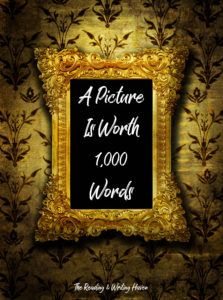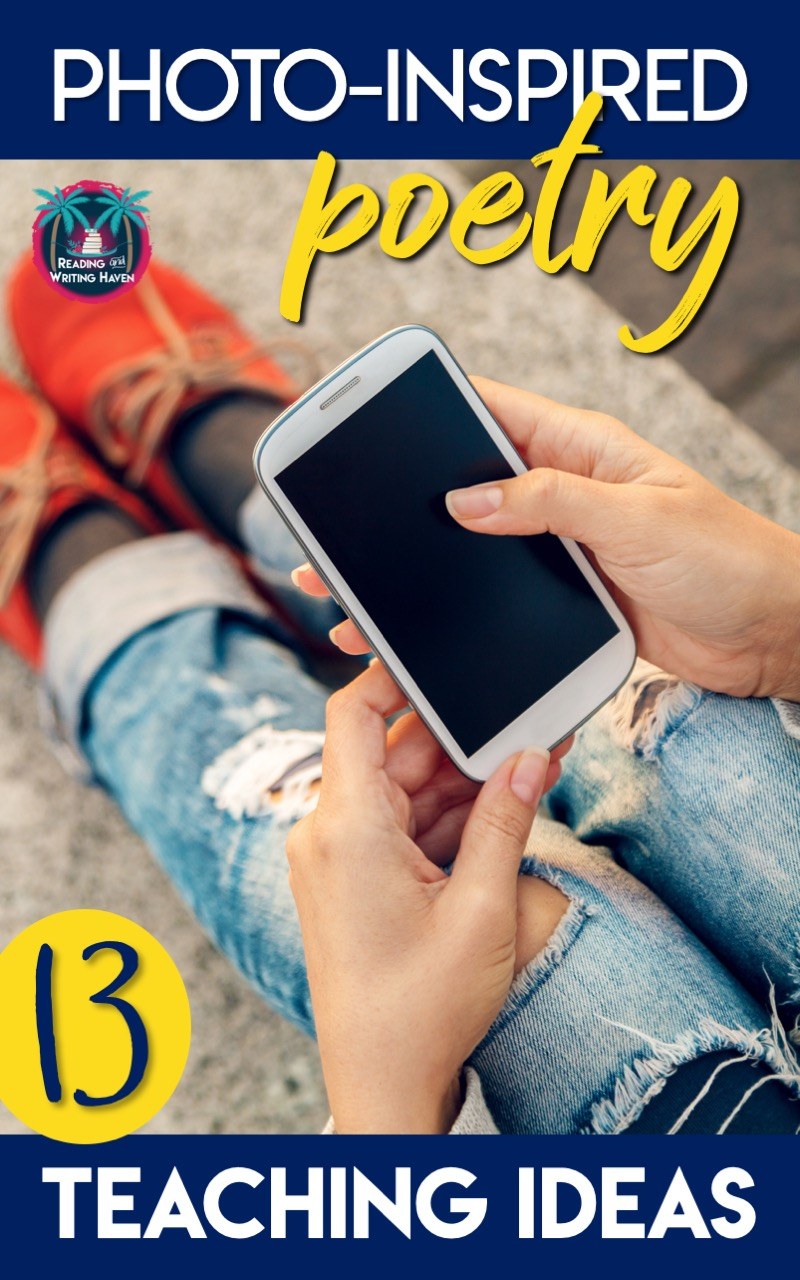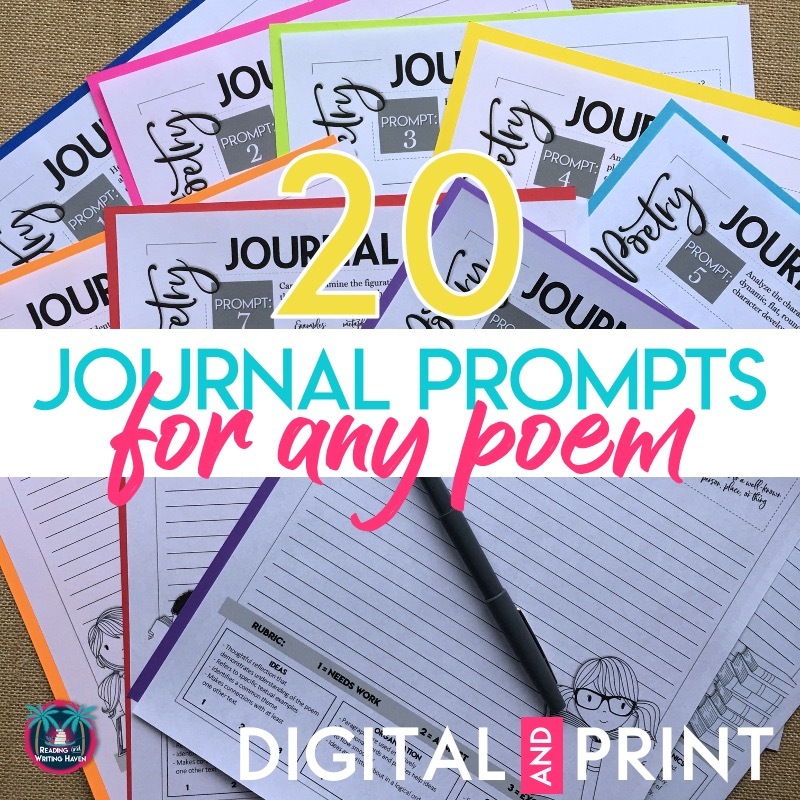How To Use A Picture As A Background For A Poem Or Writing
Pictures inspire poetry. In this post, you'll find 13 ideas to utilize in middle and high school classrooms.
What do yous call fiction writers who endeavor to write verse?Prosers.
What does the reluctant poet write?Averse.
I came beyond these puns on a list from Buzzfeed, and I couldn't assist but notice their connection to didactics poesy in the classroom. Sometimes when I ask my students to write a verse form or even just to write most a verse form they read, I get moaning and complaining and whining, and if I'm lucky, I'll get "a verse" from every student. Many students exercise feel like "prosers" when they are asked to reply to anything related to poetry — mainly the kids who strongly dislike poesy to begin with simply besides the students who realize writing poetry is not usually 2d nature.
Despite the split between poetry and pupil interest, verse has wide applicability to all kinds of lesson plans…not just in ELA classes, but in any content surface area. There's no questioning the validity of poesy. In a contempo post, I wrote about vi uncomplicated ways to brand verse engaging. In this post, I'm expanding on those ideas by focusing specifically on how teachers tin can captivate reluctant writers through images. By using something well-nigh everyone enjoys (pictures / illustrations…and let's not count out moving pictures), we tin can make poetry more than attractive to reluctant writers.

Without further ado, permit's take a await at thirteen creative ways teachers can utilize images to inspire students to write poetry.
1. Wordless pic books
Many students have heard ofThe Book with No Pictures, just non all of them are aware of books with no words. This type of children's book has a powerful potential for use in English classrooms (from elementary school through secondary school). How can wordless motion picture books be used for poetry purposes? Teachers can "read" one of these books to their class. Actually, in one of my Reading masters' classes, a professor readFlotsam (1 of my favorites) to a group of adults. He paused on each page, and the form fabricated observations about what was happening. These books tin can exist used to make inferences, to make predictions, and to develop comprehension, reasoning, and sequencing skills. After reading the wordless picture book with the grade, a teacher tin then ask students to write a poem (any style!) inspired by the book the course just read together. Perhaps students write a couplet or a quatrain to back-trail each page.
2.Texting couplets
This is a fun idea I dreamed upwards as I was thinking about how to make poesy applicable to twenty-first century students. What does nigh every student dear? Easy: cell phones and texting. Let'southward harness that passion! Text messages are usually short, and so are couplets. Take students utilize an paradigm (let them get creative…they tin can take a selfie, accept pictures of nature or with their friends, tape a video, cut out a picture from a magazine, print a picture from the Net, or even depict a picture) as inspiration for a series of rhyming couplet text messages (texting couplets). You tin can see the assignment I created hither.
3.Physical poetry or illustrated poetry
There are a couple different ways to approach concrete poetry. In its true form, the words create the pic. However, in my experience teaching diverse grade levels, students who have an creative side enjoy drawing an paradigm start and then filling in the illustration or outlining information technology with their poesy. I say….why fight that boxing? If students sympathize the difference betwixt concrete poetry and the artistic bending they are choosing to take, what harm is done? Google and Pinterest both showcase some incredible examples of how students can either use words to make a flick or how they tin draw a picture and fill it in with poesy.
4.Old family photographs (or but whatever quondam photo)
Not all students have access to old family photographs (this wouldn't be practical to demand from all students, and so information technology would make for an excellent choice assignment); nonetheless, the idea tin can employ to photographs of whatever kind. Most parents would probably appreciate their children taking an interest in nostalgic family relics. You can ask students to bring in ane or several photographs that students find inspiring and interesting. Assistance students brainstorm by asking them to write down words that describe the photo as well as having them call up about how the picture makes them feel. Students can then write sentimental poems or humorous ones based on these images. They could likewise consummate this assignment after taking their own pictures…new ones.
Hither'south an example I wrote (which proves yous don't accept to exist "proficient" at writing poetry to benefit from the learning experience):

Brainstorming List (Observations):
- Dog and true cat
- Bluish, white, brown
- Laptop
- Desk
- Glasses
- Curiosity
- Companions
Poem:
The dog peers into my optics.
Silently asking
Will you pet my sides?
The true cat creeps upward from behind.
Proudly purring,
Merely trying to unwind.
No working today;
Today we play.
Friends for life.
5.Drawing strips
We all know the pupil who loves to draw or truly enjoys a practiced graphic novel. Try offering students the opportunity to utilize the graphic novel or comic strip format for poetry writing inspiration. This assignment could work a couple dissimilar ways. 1) Students could cull an existing comic strip or several pages from a graphic novel. They could white out the text and fill in the blanks with poesy. 2) Students who enjoy drawing could illustrate their own comic strip or graphic novel pages from flake and also write poetry to accompany the images.
6.Vi-room poems
6-room poems are effective for many of my students because it structures their brainstorming into specific categories and makes drafting the actual poem easier. How can a vi-room poem relate to a picture? Quite easily. Just have students choose a photograph or fifty-fifty a video (short films piece of work wonderfully) for inspiration. They can look at the moving picture as they begin ideas for each of their rooms. If y'all've never heard of a vi-room verse form or if you lot're not sure how to go nearly pedagogy students to write one, this resource can get you started.
vii.Instagram photo with caption
Instagram appeals to a wide age-range. Why? The pictures! People love scrolling through pictures on social media and reading the captions. Students can get artistic with their Instagram images by captioning them with a short verse form (a haiku, tanka, limerick, or cinquain, for example). This option is too a perfect artery for artistic students to practice their photography skills.
viii.Hashtag poems
Hashtags are another pop element related to social media, and often, they are used in motion picture captions. They're and then catchy. Teachers tin can inquire students to think exterior of the box about hashtags. Why not use them to write poems? They could be the merely element of a poem (100% pure hashtag), they could be an important element in the poem, or they could only be used at the cease of the verse form for event. Think of the hashtag as the new form of figurative language. Students can use them in the same fashion they apply metaphors, personification, hyperboles, foreshadowing, repetition, symbolism, sound devices, puns, and etcetera. This website has some examples (some school-appropriate, some not); my favorite is the 1 titled "#hashtag" by Dara Brown.
9.Inspirational establish poem using quotes
I'm sure you've seen quotes that are crafted into images. They're pretty pervasive in our order. There's something about a cute visual quote that is cathartic for the soul. Inquire students to compile a list of their favorite quotes for homework or as an in-grade research assignment. So, accept them create a constitute poem using only words from these quotes. They tin can produce the concluding draft of their institute verse form on their very own original quote image (hand-drawn or computer-generated). Use them to decorate your classroom!

10.Political cartoons
Every twelvemonth, I have students who want to run for president, and if they don't want to, they should. They LOVE politics. These students might enjoy an assignment where they are asked to create their own political cartoon or utilize an existing ane and write a verse form to accompany it. Harness your students' interests when it comes to poesy, and their investment and attitudes will improve.The New York Time'south Upfront magazine is a wonderful place to start because their cartoons besides take corresponding questions for analysis.
11.Satirical illustrations
Someone shared this article on Facebook, and when I saw it, I began brainstorming the PLETHORA of means teachers could utilize these satirical visuals in the classroom. Without a doubt, they could be inspiration for poesy. These particular images specifically focus on applied science problems in our social club. Teachers tin can ask students to find a satirical visual text they capeesh and then write a poem based off of the picture they discover.
12.Famous paintings
When considering what types of visual texts are worthy of classroom analysis, we shouldn't leave out well-known artwork, like Salvidor Dali'southPersistence of Memory, Van Gogh'sThe Starry Night,and Grant Wood'sAmerican Gothic. To prepare students to write this type of poetry, you can show them how throughout time, poetry has actually inspired paintings. Demand somewhere to first? This website has skilful examples. Once kids can encounter how a painting has been inspired by a verse form, it might be easier for them to do the reverse by analyzing artwork to develop original poetry.
thirteen.Read poems about pictures and and so write an original
And while we're at it, students might as well read poems about pictures then write an original!
Regardless of which type of paradigm students are using to inspire their poesy, teachers can guide students during the brainstorming stage by prompting them with questions, helping them call back through the options for how to create their poesy, and even allowing them to create their own rubric based on self-adamant criteria. You tin view the brainstorming assignment I apply with my students here.
To take it one step further, teachers tin scaffold the poetry writing assignment by brainstorming possible topics, themes, and even words to include in the poems. Do you have students who withal need more support? Write the kickoff few lines of the poem together as a class, and let them finish it on their own.
The main observation I've noticed about didactics poetry is that the more requirements I requite and the more "perfect" I expect the final production to exist, the more resistance I get from students. Poesy doesn't accept to be perfect. For the purpose of verse in the classroom, merely encouraging students to write and learn about the construction of a poem is a success.
A picture is worth a chiliad words, but when it comes to poesy, we merely need a few. Pictures, illustrations, images (of whatsoever kind) can inspire thoughts and ideas students might not otherwise have discovered. Try using pictures to inspire verse with your students, and let their creativity lead the mode.
RELATED Resources
Whether students are writing poetry or writing about poetry, it helps to offer choices. This resources features twenty periodical prompts with a variety of angles for responding to poetry. They are included in both digital and print versions. Click on the epitome to view more details.

How To Use A Picture As A Background For A Poem Or Writing,
Source: https://www.readingandwritinghaven.com/13-ways-pictures-can-inspire-students-to-write-poetry
Posted by: graingermisiongs.blogspot.com


0 Response to "How To Use A Picture As A Background For A Poem Or Writing"
Post a Comment